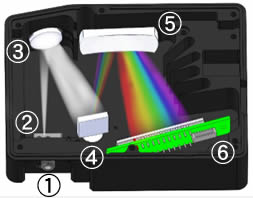How to choose a compact spectrometer (Beginner's Guide)
M.Sc. Kimihiro Kinugasa
1. Introduction
A spectrometer is a device that separates light containing various wavelengths according to their wavelength (spectral dispersion) and measures their intensities with a detector. A spectrophotometer is a device that irradiates a sample with spectrally separated light and measures its transmission or reflection at each wavelength.
The optical structure of the SEC2121 Spectrometer from the SEC2120 Spectrometer System is shown below.

Schematic diagram of the internal structure of a spectrometer.
② Slit
③ Collimating mirror
④ Grating
⑤ Focus mirror
⑥ 2048 element CCD array
2. Key points for choosing a spectrometer
The first thing a user should focus on is whether the device meets the intended measurement purpose, what they want to measure, whether its wavelength range and wavelength resolution are compatible with the characteristics of the target sample.
2.1. The detectable wavelength range of the device must be selected based on specific measurement requirements:
- Ultraviolet region (UV): Suitable for absorbance measurements and thin film thickness measurements.
- Visible region (Vis): The most commonly used region, suitable for color measurements and food inspection.
- Near-infrared region (NIR): Often used for analyzing the components of food and pharmaceuticals or measuring moisture content, taking advantage of its high transmittance.
The measurable wavelength range is mainly determined by the grating line count, the type of sensor, and the number of horizontal pixels.
2.2. Balance between measurement accuracy and sensitivity
Wavelength resolution (full width at half maximum, FWHM) which indicates how finely light can be separated, is an important parameter.
- Factors determining resolution: Resolution is determined by the combination of the entrance slit width, the grating line density, and the number of horizontal pixels on the sensor.
- Trade-offs: Reducing the slit width to improve wavelength resolution decreases the amount of light entering the spectrometer, lowering sensitivity (throughput). Similarly, a higher number of sensor pixels (higher pixel density) increases resolution, but the smaller area of each pixel reduces sensitivity. Increasing the grating line density improves resolution, but narrows the measurable wavelength range.
- Optimal slit width: To obtain low-noise data, a narrower slit is not always better. In applications such as fluorescence measurements, the slit width needs to be increased to ensure sufficient light throughput.
- Configuration selection: The physical setup of the device should be chosen according to factors such as the type and quantity of the sample and the measurement method.
3. Summary of selection points
There is always a trade-off between the factors that determine the performance of a spectrometer. Therefore, for general applications purpose, a configuration that balances the strengths of each component is required. Selection should consider the grating line density, slit width, number of pixels on the detector, balance of detector sensitivity, exposure time, and the signal-to-noise (S/N) ratio.
3.1. Reason 1 for choosing the SEC2121 Spectrometer: Achieving both wide wavelength wange and high resolution
3.1.1. Trade-off Between Resolution and Detector
- Theoretical Resolution Calculation
Using a 1024-pixel CMOS sensor, the theoretical resolution over an 825 nm bandwidth is 0.8 nm/pixel.
However, the actual resolution is limited by the entrance slit (25 µm) and the grating line density, resulting in a practical lower limit of 1.4 nm.
Even if upgraded to a 2048-pixel sensor, the resolution remains constrained by the optical system and cannot surpass 1.4 nm. Additionally, smaller pixel size (14 × 200 µm) may lead to reduced sensitivity.
- Sensitivity Advantage
The SEC2121's 1024-pixel sensor features large 28 × 200 µm pixels, doubling the light-sensitive area compared to the 2048-pixel sensor, resulting in over 100% sensitivity improvement in the visible range. As shown by the red line in Figure 2, its signal-to-noise ratio is significantly superior to conventional small-pixel designs.
3.1.2. Impact of Key Technical Parameters
- Entrance Slit: The 25 µm slit maintains good resolution while avoiding signal attenuation caused by excessively narrow slits.
- Grating Performance: The diffraction grating covering 200–1025 nm is optimized in line density to efficiently disperse light over the 825 nm bandwidth.
- Sensor Characteristics: The low-noise design of the CMOS sensor (e.g., PPD pixel structure) further enhances weak-light detection capabilities.
3.1.3. Recommended Application
This configuration is suitable for applications requiring high sensitivity but not extremely high resolution.
Note: Achieving higher resolution would require simultaneous optimization of grating line density and slit width, which may come at the cost of reduced sensitivity.
The current SEC2121 design achieves a practical sufficient and user-friendly balance, making it an ideal choice for most laboratories.

Sensitivity comparison
SEC2121, 1024-element
2048-element detector
SEC2021, 2048-element
SEC2121 is particularly sensitive in the UV region
// -光源稳定性增强:集成自适应光源驱动电路,动态调节输出功率,避免单一波长过强导致的检测失真。
// 瞬变光谱应用案例
// 线性校正保障

